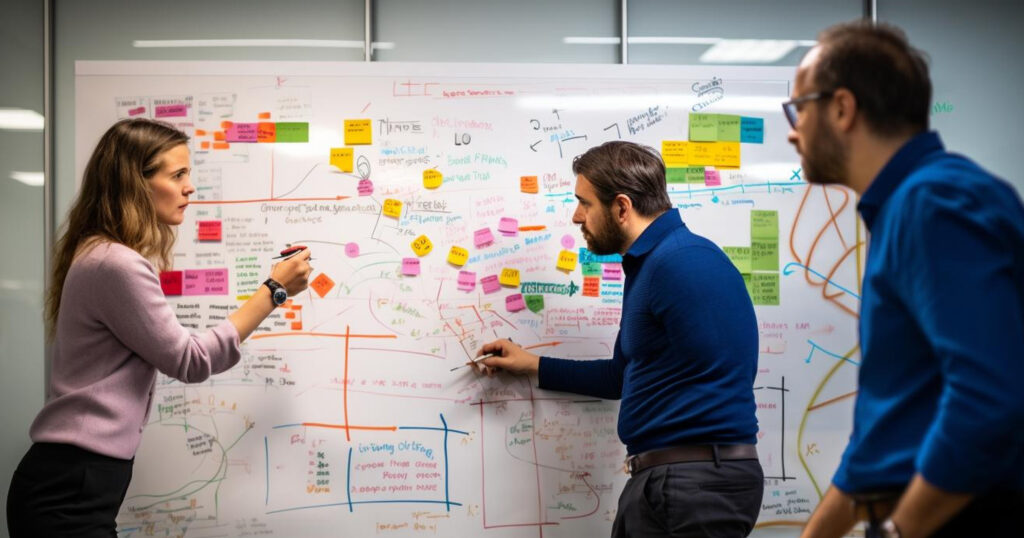Ever played a game where you chart a course into unexplored territories? That’s precisely what startups do in the business realm.
They venture into the unknown, armed with ambition and innovation. But it’s no child’s play. It requires a strategic compass called ‘experimentation.’
Let’s together understand how to map out this well-structured roadmap to success!
Setting the Stage for Experimentation

Before an actor delivers a stellar performance, there’s rehearsal – the preparation behind the scenes that sets the stage for success. Similarly, before diving into the intricate world of startup strategy, we must lay down the foundational understanding.
The Startup Landscape
Imagine a seed. Small, yet teeming with potential. That’s a startup – a nascent business with dreams larger than life, closely studying human behavior to align with its audience.
Unlike established trees (businesses) with deep roots, startups are nimble saplings, swaying and adapting to the winds of the market.
Do you recall a time when you began something from scratch? Remember that fiery spirit? That’s a startup for you!
The Importance of Agility in the Startup Realm
Picture a dancer moving fluidly, adapting to rhythm changes. In the bustling ballroom of business, startups are the agile dancers. Their expected outcome? Gracefully pivot to new market tunes. Their ability to switch directions, iterate, and innovate on-the-go, isn’t just impressive; it’s vital.
Have you ever had to change plans swiftly? Think of that agility, now multiply it – that’s the daily dance of a startup.
Role of Innovation in Driving Growth
If startups were vehicles, innovation would be their fuel. It’s the propellant that drives them, ensuring they not only keep up but often lead the race, thanks to their optimization program.
Think about the last product that wowed you. The chances are high that it came from a startup’s innovative idea.
The Evolving Needs of Startup Consumers
Generally speaking, much like our ever-changing music playlists or Netflix queues, the needs and wants of startup consumers are in constant flux. For startups, staying in sync with these changes isn’t just beneficial; it’s survival.
Remember the last time your preferences changed? That��’s how dynamic the startup consumer’s needs are and why it’s crucial to keep a finger on the pulse.
Why Experimentation Matters
Have you ever tried a new recipe, tweaking ingredients here and there until it tastes just perfect? That’s experimentation in its essence.
In the startup world, the stakes are higher and the ingredients more diverse, but the principle remains the same. Let’s uncover why this iterative tweaking – this experimentation – is paramount for startups and their CRO (conversion rate optimization) efforts.
- Enhancing product-market fit: Think of a puzzle piece seamlessly fitting into its designated spot. That’s what startups aim for with their products in the market. Through experimentation, startups can refine their products, ensuring they not only meet but resonate with consumer needs. It’s the bridge that connects a startup’s offering with the market’s heartbeat.
- Proactive problem-solving: Remember those “Choose Your Own Adventure” books where you determine the story’s outcome? Experimentation enables startups to foresee potential storylines and desired outcomes. By actively testing and iterating, they can predict challenges and proactively devise solutions, ensuring their story doesn’t end prematurely.
- Maximizing ROI on limited resources: Imagine a backpacker with limited supplies, making every item count. Startups often operate on limited resources, be it time, money, or manpower. Through strategic experiments, they ensure maximum impact, making every dollar, every minute, and every effort count.
- Staying ahead of competition: In the race of business, it’s not just about speed but also direction. Experimentation helps startups gauge market reactions, adapt faster, and always stay one step ahead of competitors. It’s their secret sauce to not just keep up but to set the pace.
- Iterative improvements and adaptability: Picture a sculptor chipping away to perfect their masterpiece. That’s what startups do with their products and strategies. Through constant experimentation, they refine and evolve, ensuring they remain relevant and effective in a dynamic market.
Mindset Shift: From Guesswork to Evidence
In the grand game of business, especially in the startup sphere, going by ‘gut feeling’ can be akin to playing darts blindfolded.
Sure, there’s a thrill, but wouldn’t it be so much more satisfying (and successful) if you could see the target clearly? This is where the critical shift from relying on guesswork to being driven by evidence comes into play.
Overcoming cognitive biases: We humans, in all our complexity, often fall victim to our own cognitive biases. You know that little voice in your head that says, “This is how it’s always been done,” or “I just feel this is right?” That’s often a cognitive bias, speaking.
In the business world, these biases can cloud judgment and stifle innovation. Just like removing smudges from glasses to see clearly, overcoming these biases lets startups view opportunities and challenges in a clearer light.
The fallacy of “if it ain’t broke”: The age-old saying “if it ain’t broke, don’t fix it” might work for grandpa’s old radio, but in the lightning-paced world of startups, it’s a mindset that can spell stagnation.
The goal isn’t just to keep things running but to perpetually improve, innovate, and evolve. Think of it as upgrading your smartphone. Why settle for satisfaction when excellence is within reach?
Using data as the voice of the consumer: In a world that’s increasingly digital, data has become the new gold. But more than its monetary value, it represents the voices, preferences, and behaviors of consumers. To make the most out of this goldmine of information, one should always have a strong call to action (CTA) that drives consumer interaction and boosts CRO efforts.
It’s like having a direct line to your customer’s thoughts. By treating data as a treasure trove of insights, startups can attune themselves more closely to what their audience truly desires. Have you ever wished businesses just understood what you wanted? Well, with data, they can.
Advantages of proactive testing: Waiting for problems to surface is reactive. Proactive testing, on the other hand, is about seeking out potential pitfalls or opportunities before they manifest.
It’s the difference between dodging a surprise hurdle and having the foresight to remove it from your path. Startups that proactively test are akin to expert chess players, always thinking several moves ahead.
The continuous learning cycle: One experiment is just a single note in the symphony of startup growth. It’s the continuous rhythm of testing, learning, adapting, and iterating that forms the beautiful melody of progress. Just as we continually grow and evolve as individuals, so must startups in their quest for success.
Laying the Groundwork for Your Roadmap

Before constructing a house, you lay its foundation. Before setting out on a journey, you ensure you have the right map.
Similarly, before diving deep into the world of experimentation, we need a solid framework—a foundation upon which our strategies, tests, and iterations can stand firm. Ready to lay the foundation?
Vision, Mission, and Experimentation
Embarking on the journey of experimentation without aligning it with your vision and mission is like setting sail without a compass. It’s the company vision that paints the picture of the destination, the mission that carves out the path, and experimentation that helps navigate through uncharted waters.
Reflecting your core values in tests: Every experiment is an extension of what your startup stands for. Let’s take an example: if sustainability is a core value of your brand, how does that translate into your experiments?
Perhaps you’re testing eco-friendly packaging or digital solutions that reduce waste. Just as a mirror reflects your image, your experiments should echo your values. Think about it – what are the core values of your (hypothetical or real) startup?
Ensuring alignment with long-term objectives: Remember setting up dominos as a kid, each piece carefully aligned to create a cascade effect? That’s how your experiments should connect to your long-term goals.
They aren’t isolated endeavors but stepping stones toward a grander vision. If you were to visualize your startup’s future in 5 years, what does it look like? And how can experiments today lead you there?
The synergy between brand and experimentation: Imagine your brand as a character in a story. Every experiment adds depth, shades, and layers to this character, making it more relatable and compelling.
It’s not just about what you test but how it strengthens and reinforces your brand narrative. If your startup was a book, what story would your experiments tell?
Making experimentation a cultural norm: Creating a culture of experimentation is like turning a room into a brainstorming hub, where ideas fly, failures are celebrated, and every hypothesis is a new adventure.
It’s about understanding how to prioritize tests that can nurture an environment where ‘why not?’ replaces ‘why?’. Think of the most innovative workspace you’ve encountered. How did it feel? That’s the energy to channel.
Prioritizing vision-driven hypotheses: In the vast sea of possible tests, not every experiment is worth pursuing. It’s the vision-driven hypotheses – those tightly knitted with the brand’s core purpose – that should be at the helm.
It’s like choosing which seeds to plant in a garden, selecting those that’ll blossom and resonate with the landscape’s overall design.
Building a Multifaceted Team
Imagine you’re assembling a superhero team to save the world. Would you recruit heroes with the same powers? Of course not! Each hero brings a unique skill to the table, contributing to a team that’s more formidable together than they could ever be individually.
Now, transpose this idea to the startup ecosystem. Building a dynamic team is akin to assembling that superhero squad, with each member offering a distinctive skill set crucial for the venture’s success.
Role of diverse skill sets: In a world that’s rapidly evolving, relying on a homogenous team is like trying to paint a masterpiece with just one color. The beauty emerges when diverse skill sets converge, creating a tapestry of ideas, perspectives, and solutions.
From tech wizards to communication mavens, every individual amplifies the team’s capacity to innovate, adapt, and thrive.
The importance of data literacy: Picture data as the secret code that, when deciphered, offers invaluable insights. It’s the modern-day spellbook. But to harness its power, you need wizards who can interpret it.
Data literacy isn’t just about crunching numbers; it’s about gleaning stories, spotting patterns, and predicting trends from those numbers. In today’s data-driven landscape, it’s a non-negotiable skill for any progressive team.
Encouraging creative problem-solving: Problems are inevitable. But here’s a twist: consider them as puzzles waiting to be solved. Encouraging a mindset that views challenges as opportunities for creative solutions fuels innovation. It’s not just about fixing things; it’s about reinventing, reimagining, and revolutionizing solutions.
Aligning team objectives with company goals: Envision a rowing team. If everyone doesn’t row in the same direction, the boat either goes in circles or sinks. Similarly, while individual team members might have unique roles, their objectives should harmonize with the overarching company goals.
This alignment ensures that the collective effort propels the startup forward, preventing discordant pulls that could stall progress.
Fostering a culture of feedback: Remember the age-old game of ‘Chinese Whispers’? How does a message get distorted as it passes from one person to another? In startups, clarity and constructive feedback are paramount.
It’s about creating an environment where feedback, whether praise or critique, is shared openly and with the intent to improve. It’s this feedback loop that keeps the startup machinery well-oiled and efficient.
Tools of the Trade
Imagine being a chef without knives or a painter without brushes. Sounds tough, right? In the realm of startup experimentation, the right tools are the game-changers. Let’s unpack this toolbox together:
- Modern experimentation tools: From A/B testing platforms for statistical significance to heat maps, today’s experimentation tools are as diverse as they are powerful. These tools often come with detailed descriptions to guide startups, ensuring they can harness their potential to the fullest. Just like an artist’s palette, the right blend can create masterpieces.
- The role of analytics platforms: Think of analytics platforms (such as Google Analytics) as your startup’s crystal ball. They offer insights, track progress, and predict trends. In short, they give your experimentation a vision.
- Automation tools for repetitive tasks: Picture a robot doing all your mundane chores, freeing you up to focus on the fun stuff. Automation tools do just that! They handle the repetition, allowing you to concentrate on ideation, strategy, and execution. In a startup where time is gold, who wouldn’t want a helper bot?
- Integrating tools for seamless operations: Imagine a symphony where every instrument plays in harmony. Integration ensures your tools aren’t just co-existing but collaboratively thriving, streamlining operations.
- Regular tool assessments and updates: Tools, like everything else, evolve. Regular check-ins ensure you’re not stuck with a rusty toolbox but are equipped with the latest and greatest.
Crafting Comprehensive Experiments

In the world of startups and innovation, crafting comprehensive experiments can be the key to unlocking unparalleled growth and insights.
Let’s take a deep dive into how one can create a well-structured experimentation process, prioritize effectively, and harness the power of prototyping and MVPs.
Structured Experiment Design
Setting up a structured experiment is like laying the foundation for a house. It’s crucial for its success. And in this context, the house is your startup’s growth and innovation trajectory.
- Ensuring reproducibility: An experiment is only as good as its reproducibility. Ensure that others can replicate your tests to validate results and build upon your findings.
- Importance of clear documentation: Maintain meticulous records of every step, hypothesis, and outcome. Clear documentation aids in revisiting experiments, training new team members, and avoiding the pitfalls of past mistakes.
- Factors to consider in sampling: Be deliberate in choosing a sample size and demographic. Understand biases, ensure representativeness, and ensure that the sample accurately reflects the larger audience or market.
- Setting controls and variables: A sound experiment differentiates between what’s being tested (variables) and what remains constant (controls). This distinction helps in drawing clearer conclusions from outcomes.
- Predicting potential outcomes: Before launching, predict possible results. It not only aids in setting expectations but also prepares the team for pivots based on results.
Experiment Prioritization
With myriad potential experiments on the horizon, how does one decide where to invest time and resources first? Prioritization becomes paramount.
- ROI-based assessment: Consider the return on investment. Which experiments could lead to significant benefits with minimal costs?
- Impact vs. feasibility analysis: Some experiments might have a high impact but are difficult to execute, while others might be easy but offer minimal value. Strive for a balance.
- Addressing urgent business needs: Always prioritize experiments that directly address immediate business challenges or market demands.
- The Eisenhower Matrix in experimentation: Inspired by President Dwight D. Eisenhower’s decision-making tool, categorize experiments based on their urgency and importance. It aids in identifying what needs immediate attention versus what can be deferred.
- Periodic review of experiment backlog: Regularly revisit the backlog of experiments, updating priorities based on current business needs and market dynamics.
Prototyping and MVPs
In the quest for product perfection, there’s a secret weapon that startups can employ: prototypes and Minimum Viable Products (MVPs). These tools allow for rapid, real-world testing and learning.
- The lean startup methodology: Embrace the principle of building a basic version of your idea to test its viability in the real world, then learn and iterate.
- Benefits of rapid prototyping: Prototyping allows for quick feedback, saving time and resources that might otherwise be spent on the full-fledged development of untested ideas.
- MVPs for market testing: An MVP is a scaled-down version of a product that contains only essential and key features. It’s a practical, cost-effective way to gauge market response.
- Gathering qualitative feedback: Engage with users directly to understand their experiences, expectations, and pain points with your MVP.
- Iterating based on MVP outcomes: Use the feedback from MVP testing as a compass. Refine, make changes, and retest until you hit the sweet spot of market fit.
Decoding Key Performance Indicators (KPIs)

Ever heard the phrase, “What gets measured gets managed?” In the dynamic world of startups, Key Performance Indicators (KPIs) are the compass that guides a business towards its North Star.
Let’s decipher the nuances of KPIs and how they can be harnessed effectively.
KPI Essentials
A KPI is a measurable value that showcases how effectively a company is achieving its business objectives. They serve as actionable metrics, guiding businesses toward success.
- Aligning KPIs with business objectives: Your KPIs should mirror your ambitions. For instance, if customer satisfaction is a goal, a related KPI might be Net Promoter Score (NPS).
- Primary vs. secondary KPIs: While primary KPIs directly relate to business goals (like revenue), secondary KPIs support the primary ones (like website clicks leading to sales).
- Avoiding the trap of vanity metrics: It’s tempting to celebrate key metrics that look good on paper, but do they drive action? Focus on metrics that matter, not just those that look impressive.
- Periodic KPI reviews and adjustments: Business landscapes evolve. Review KPIs regularly to ensure they remain relevant and reflective of current business goals.
Monitoring and Measuring
Measurement is the first step that leads to control and, eventually, to improvement. Let’s delve into the how-to of KPI tracking.
- Using dashboards for real-time insights: Dashboards visually represent data, offering an instant snapshot of where a business stands concerning its KPIs.
- Importance of clean data: Garbage in, garbage out. Ensure data accuracy and consistency for trustworthy insights.
- Correlation vs. causation in KPIs: A rise in ice cream sales might correlate with a rise in sunglasses sales, but one doesn’t cause the other. Understand the difference to draw meaningful conclusions.
- Addressing anomalies and outliers: Spikes or drops in KPIs can be due to various reasons. Investigate anomalies to discern true trends from mere flukes.
- Continuous KPI benchmarking: Regularly measure your KPIs against industry standards or past performance to track progress and set future targets.
Translating KPIs into Action
Numbers tell a tale, but it’s upon businesses to interpret that story and craft their next chapter.
- Understanding the “so what” of KPIs: Your website traffic increased by 10%. So what? Delve deeper to understand the implications, be it increased brand awareness or effective marketing.
- KPI-driven strategic decisions: Let your KPIs guide your business choices. If customer retention rates are falling, perhaps it’s time to revisit your customer service strategy.
- Recognizing saturation and diminishing returns: If adding more ads doesn’t proportionally increase traffic, maybe it’s time to rethink your advertising strategy.
- Agile responses to KPI trends: In the startup world, agility is a superpower. Respond promptly to KPI trends to harness opportunities or mitigate challenges.
- Integrating KPI insights into future experiments: Use KPI data to inform your experimentation roadmap, ensuring that tests and trials align with what the numbers indicate.
Risks, Failures, and the Road to Resilience

Dive into the world of experimentation, and you’ll soon discover risks and failures aren’t obstacles. They’re accelerators for growth.
Embracing the Value of Failure
Let’s play a game of word association. Say “failure,” and most people think “mistake” or “loss.” But in the startup realm, savvy innovators see a different picture. They see “opportunity.”
Why? Because failure offers invaluable lessons. Each misstep, while initially stinging, reveals crucial insights. It’s a real-time feedback system, helping us understand what doesn’t work, why it doesn’t, and what might work better next time.
Remember, every groundbreaking innovation we admire today is the result of countless experiments, many of which didn’t hit the mark. It’s in those misses where genuine innovation often hides.
Risk Management in Experimentation
Alright, let’s be detectives for a moment. Before launching any experiment, it’s smart to identify potential pitfalls. What could go wrong? Where are the vulnerabilities?
Once we’ve listed them out, we craft strategies to mitigate them. Think of it as our experimentation safety gear. It doesn’t mean we won’t face challenges, but it equips us to handle them better.
The importance of having a Plan B (or even C and D) can’t be overstated. Contingency planning isn’t about pessimism; it’s about preparedness. It ensures we can pivot swiftly without derailing our primary objectives.
Just as a doctor has regular check-ups, our experiments need periodic risk assessments. Changes, both internal and external, can introduce new vulnerabilities, and we need to be on top of them.
Lastly, cultivate a safety net. This isn’t just about having backup plans but also about fostering a culture where taking calculated risks is celebrated and learning from missteps is seen as progress.
This safety net ensures that even when experiments don’t go as planned, the spirit of innovation remains undeterred.
Beyond the Numbers: Qualitative Insights

In the realm of experimentation, numbers and data-driven insights are king, right? Well, not entirely. There’s another kingdom, often overlooked but equally powerful: the world of qualitative insights.
Here, human experiences, feelings, and perspectives hold the scepter.
The Power of Human Feedback
Imagine a cafe where no one ever tells the barista how they feel about their coffee. Crazy, right? In the startup universe, operating without human feedback is just as baffling.
- Surveys and Feedback Forms: Think of these as quick temperature checks. A pulse on how you’re doing and where you can tweak.
- User Interviews and Focus Groups: This is your deep dive. An opportunity to explore the “whys” behind the numbers and understand motivations, challenges, and aspirations.
- Observational Studies: Sometimes, what users do speaks louder than what they say. Observing them in their natural habitat can unveil some profound insights.
- Feedback-driven Product Enhancements: Listening is good; acting on what you’ve heard is even better. Use feedback as your guidepost for making product enhancements that truly resonate.
- Maintaining a User-centric Approach: Never lose sight of this. Your users aren’t just data points; they’re the heartbeat of your startup. Nurture this relationship, and your venture will thrive.
The Role of User Personas
Creating a product without understanding your users is like baking a cake for someone without knowing their favorite flavor.
- Crafting Detailed User Personas: Dive deep. Who are they? What drives them? What challenges them? The more vivid the picture, the better.
- The Iterative Nature of Personas: Just as people evolve, so should your personas. Don’t let them collect dust. Regularly revisit and refine them.
- Using Personas in Experiment Design: With a clear persona in hand, crafting experiments becomes more intuitive. You can better predict reactions, preferences, and pain points.
- Ensuring Alignment with Target Demographics: Your personas should mirror your target audience. If there’s a mismatch, it’s like trying to fit a square peg in a round hole.
- Periodic Persona Reviews and Updates: Think of it as a regular health check-up for your personas. Ensure they’re still representative of your evolving user base, tweaking and updating as necessary.
Navigating Market Dynamics

When you’re driving a car, you don’t just look straight ahead; you glance at the rearview mirror, check the side mirrors, and occasionally peer over your shoulder.
Similarly, in the fast-paced world of startups, keeping an eagle eye on the evolving market dynamics is pivotal. It’s about staying alert, adapting, and making informed choices.
Staying Updated with Trends
Picture this: the market as a bustling, ever-changing metropolis. Skyscrapers rising, old structures making way for the new. To thrive, one must not only be a resident but an observant one.
Recognizing the importance of market awareness is step one. It’s akin to having your finger on the city’s pulse, feeling its heartbeat, and predicting its next move.
Now, how do we stay updated? Enter tools and platforms dedicated to trend tracking. From market analysis platforms to social listening tools, they’re the binoculars offering us a clear view of the evolving landscape. By leveraging these, you’re positioning yourself in the heart of the metropolis, aware and ready.
Lastly, awareness isn’t just about observation; it’s about analysis. How do these trends affect your business? What doors of opportunity do they open or close? Being in the know is great, but understanding the implications? That’s the golden ticket.
Competitive Analysis in Experimentation
If the market is a grand chessboard, your competitors are the opposing pieces. It’s not just about your moves but understanding theirs.
Identifying key competitors is more than listing names. It’s about understanding who they are, what they’re offering, and how they’re maneuvering the board.
Next, deep dive into their strengths and weaknesses. This isn’t about imitation but about comprehension. It helps in discerning opportunities they’re missing or threats they pose.
Lastly, and most intriguingly, dissect their strategies. Not just what they’re doing but how and why. What can you learn? Where do they shine, and where do they falter? By gleaning insights from competitor strategies, you’re not just playing the game; you’re strategizing to win it.
Scaling and Adapting Your Experimentation Process

As startups mature and expand, so does their appetite for experimentation. However, with growth comes complexity. Scaling isn’t merely about doing “more” but evolving to be “better.”
And how do we navigate this expansion? Let’s break it down.
The Evolution of Experimentation
- Adapting Processes: Like how a caterpillar transforms into a butterfly, startups undergo metamorphosis. This change necessitates that experimentation methodologies evolve in tandem with the organization’s needs.
- Navigating Challenges: Scaling experiments isn’t a walk in the park. From resource constraints to data discrepancies, hurdles will appear. The key? Anticipate, prepare, and strategize.
- Tool and Resource Evaluations: Think of this as your toolbox check. Are the tools still sharp? Are they relevant? Periodic evaluations ensure you’re equipped with the best in the game.
- Training and Onboarding: As your team grows, ensuring everyone’s on the same page becomes paramount. Robust training programs not only equip but also invigorate team members.
- Experimentation Spirit: Here’s a challenge: As we scale, how do we keep that initial spark, that zest for experimentation, alive and kicking? The secret lies in cultivating a culture that values curiosity and celebrates exploration.
Cross-Functional Collaboration
- Bridging Silos: Growing startups can sometimes unintentionally create isolated departments. Break those walls! Collaboration is the name of the game.
- Interdisciplinary Experiments: Magic happens when marketing meets engineering or when design collaborates with data. Fostering such intersections can lead to revolutionary ideas.
- Sharing Insights: Picture this: A discovery in Team A can solve a challenge in Team B. By creating platforms or channels for sharing insights, we expedite problem-solving.
- Leveraging Diverse Expertise: Every team member brings a unique perspective. By combining these diverse viewpoints, we can craft richer, more holistic experiments.
- Unified Experimentation Culture: Building a culture where every department believes in, and practices experimentation ensures consistency, alignment, and collective growth.
Global Considerations in Experimentation
- Cultural Context: When taking your experiments global, it’s not just about translation but transformation. Understand and adapt to local nuances.
- Global vs. Localized Experiments: Not everything that works in one region will resonate in another. Decipher when to globalize and when to localize.
- Regulatory Navigation: Different shores, different rules. Stay informed and compliant with regional regulations to ensure smooth sailing.
- Global Insights for Innovation: Every region offers unique insights. Embrace them to innovate and cater to a broader audience.
- Culturally Sensitive Process: Respect is the foundation. Build an experimentation process that’s considerate, informed, and culturally attuned.
The Continuous Journey of Experimentation

In the realm of experimentation, the finish line is an illusion. Instead, it’s a dynamic loop where today’s end is tomorrow’s beginning. Let’s break this down:
- Reflection and Assessment: After any experiment, taking a moment to pause, reflect, and assess is invaluable. It’s like a pit-stop, allowing us to check our equipment, strategy, and testing roadmap. What worked? What didn’t? This retrospective glance ensures we gather all lessons, both from our hits and misses.
- Forward Planning: With reflections in our toolkit, we look ahead. It’s akin to setting the GPS for our next destination. Armed with fresh insights, we can set clearer objectives, refine strategies, and align our resources for the next phase of experiments.
- Embracing a Culture of Lifelong Learning: Here’s a secret sauce for innovators: never stop learning. Whether it’s from formal training, networking, or simply from day-to-day operations, continuous learning keeps us adaptable and sharp. It transforms our approach to experimentation from a one-off task to a pulsating habit, constantly evolving and improving.
In essence, the experimentation cycle is less about reaching a destination and more about staying curious, proactive, and always in motion. Keep that always in mind!

